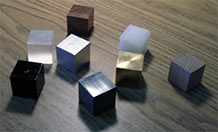How are materials the same and different?
1. Ask the question
Remind students that they have been investigating some interesting objects and their materials. Recall some of the materials they examined last time: e.g. glass and plastic. Introduce today’s question:
Brainstorm some ideas.
- How would you describe glass? How would you describe plastic? Which words are the same? Which are different?
- How would you describe wax? How would you describe jello? Which characteristics are the same? Which are different?

Point out that it is sometimes difficult to compare two materials if their objects are very different. For example, erasers and truck tires are sometimes both made of rubber, but they are so different, you might never have realized that.
- What if the objects were the same, and only the materials were different? Would it be easier or harder to compare the materials?
Now introduce the cubes, letting the students know they will be working with these cubes for the next few weeks. Explain that the cubes are all the same size and shape, but each is made of a different material. Take up the cubes one at a time and name each material so students have a chance to hear the words spoken aloud:
- pine
- oak
- steel
- copper
- aluminum
- nylon
- PVC
- acrylic
Note: See the Science Background for more information about the cube materials.
Encourage the children to comment on these materials, perhaps naming its source, remarking on its appearance, or naming some objects they know are made of the materials.
In today's investigation, we’ll examine these materials scientifically — by observing their properties and recording our findings.



